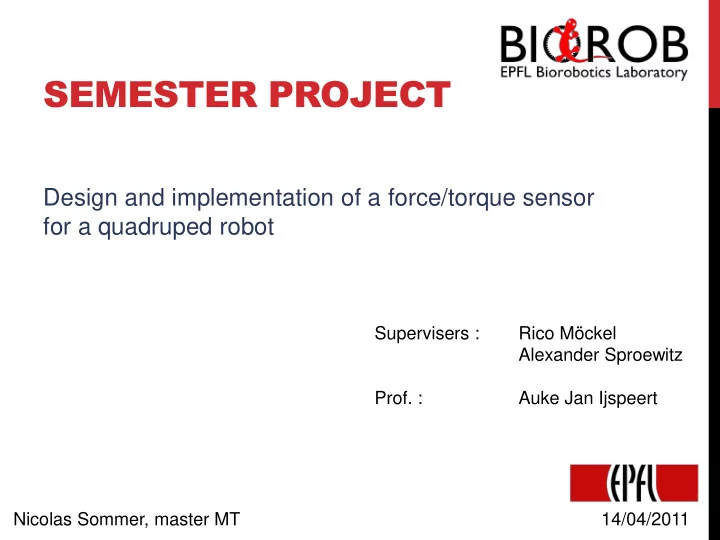

SEMESTER PROJECT Design and implementation of a force/torque sensor for a quadruped robot Supervisers : Rico Möckel Alexander Sproewitz Prof. : Auke Jan Ijspeert Nicolas Sommer, master MT 14/04/2011
PRESENTATION OUTLINE Cheetah introduction CPG’s and sensory feedback Roombots’ sensor Load-cells intro Issues with roombot’s sensor Experimental setup improvements Leg sensor design First design approach Upcoming work 2
INTRODUCTION : CHEETAH • Quadruped robot. • Study base for CPG algorithms • Goal : use real-time hardware information to find locomotion principles and improve control of the gait • 3-segment pantographic leg, 2 active DOF 3
CPG’S AND SENSORY FEEDBACK It is possible to use sensory information in a CPG so that the oscillator is better coupled with the mechanical system [1] Stop before transition / fast transition More stable gait, faster Still many challenges, open subject Cheetah : study platform [1] L. Righetti and A. J. Ijspeert. Pattern generators with sensory feedback for the control of quadruped locomotion. Proceedings of the 2008 IEEE International Conference on Robotics and Automation (ICRA 2008), Pasadena, May 19-23, 2008. 4
SENSOR FOR ROOMBOTS First part of the project : Resolve issues with previously developed sensor • Roombots • 4-axis • Strain gauges measure deformation • Experimental acquisition with labview • Simulation results do Sensor Roombots not match experiments 5
LOAD CELLS : INTRO • Composed of strain gauges • Resistivity changes with deformation Stress Forces • Measured through a Wheatstone bridge • Here, half-bridge : 𝑆 1 = 𝑆 2 = 𝑆 : fixed resistors 𝑆 3 = 𝑆 + ∆𝑆 𝑆 4 = 𝑆 − ∆𝑆 : gauges with opposite deformations 𝑗𝑜 ∗ ∆𝑆 𝑊 𝑝𝑣𝑢 = 𝑊 2 6
LOAD CELLS : INTRO 2 Multi-axis system local deformation often function of several forces N axis measured : N bridges required • Characterize the system : Apply forces and torques, measure voltages • Invert the system : Voltages forces/torques 7
ROOMBOTS SENSOR ISSUE • Experimental results do not match simulations • Simple tests for symmetries : fail incoherent reactions Possible explanations : • Bad values of the gauges / resistors (ex : 300 Ω and 360 Ω instead of 340 Ω 0,83% error) • Placement and orientation of the gauges • Gauges’ sensitivity differences (6% variation) Main problem found : electrical gauges connections between the gauges Deformation on a beam and the aluminium short-circuits despite the Same beam : insulating layer 8
EXPERIMENTAL SETUP IMPROVEMENTS • Top beam for Mz, Fz z • Pulleys • PCB for the Wheatstone bridge (double) 9
LEG SENSOR DESIGN Hypothesis : 1. Three forces between foot and floor. 2. No moments transmission. (# Floor not sticky) 3. Position of contact can be determined. Angular positions of the foot segments and body known. 𝐺 0 𝑦 θ 𝐺 0 𝒰 𝑔𝑚𝑝𝑝𝑠→𝑔𝑝𝑝𝑢 = 𝑧 𝐺 0 𝑩 α 𝑨 z ϕ . x 𝐺 𝑁 𝑦,𝐶 = 𝐺 𝑧 ∗ 𝑨 𝐵𝐶 − 𝐺 𝑨 ∗ 𝑧 𝐵𝐶 y 𝑦 𝐺 𝑁 𝑧,𝐶 = −𝐺 𝑦 ∗ 𝑨 𝐵𝐶 = 𝑧 𝐺 𝑁 𝑨,𝐶 = 𝐺 𝑦 ∗ 𝑧 𝐵𝐶 𝑨 B 𝑪 10 A
FIRST DESIGN APPROACH • With previous hypothesis : • 3 forces unknown : 3-axis sensor • Possibility to choose which axis to measure • Design inspired from robot’s finger 6 -axis sensor [1] • Small, already tested and very precise 2-3cm • Same range of forces • One Wheatstone bridge sensitive to only one axis by design • Possibility to easily use it as 6-axis • Contact between foot and floor more flexible • Or better accuracy [1] G-S Kim 2004 Development of a small 6-axis force / moment sensor for robot’s fingers. 11
FIRST DESIGN Solidworks FEA simulations APPROACH 2 Gauges position Fx Fy Fz 12
UPCOMING WORK QUESTIONS? 13
Recommend
More recommend